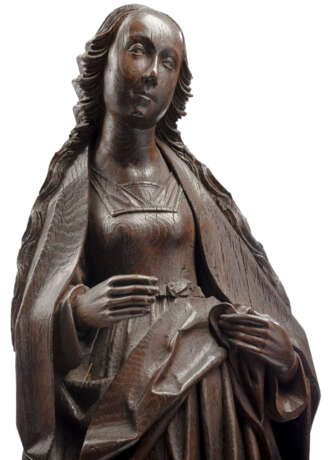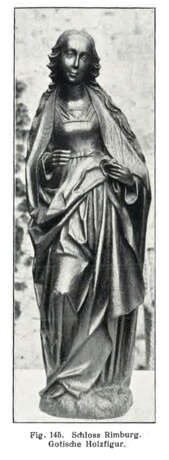ID 678055
Lot 2796 | Meister der von Carbenschen Gedächtnisstiftung (attr.)
Estimate value
€ 8 000 – 15 000
H. 90 cm
Weibliche Heilige oder Verkündigungsmadonna. Eiche, rückseitig ausgehöhlt und mit einem gewölbtem Eichenbrett verschlossen. Rechte Hand ergänzt. Attribut fehlt. Oberfläche mit diversen Schwundrissen. Sockelbereich mit kleineren Schäden.
Aus altem deutschen Adelsbesitz, Schloß Rimburg bei Aachen, sehr wahrscheinlich von der Kunstsammlerin und Besitzerin des Schlosses Johanna von Brauchitsch (geb. Weckbecker) im späten 19. Jh. erworben. Da unsere „Weibliche Heilige“ vollrund geschnitzt ist, zwar ausgehöhlt, aber mit dem sogenannten Verschlußbrett wieder geschlossen, darf man davon ausgehen, daß sie im Kirchenraum frei stand, rundum sichtbar, also nicht in einem Altarretabel Aufstellung fand. Einzig ihre rechte Hand (authentisch ergänzt) könnte einen Gegenstand gehalten, getragen haben; die Linke greift in das aufgeschlagene Ende des Manteltuches - für aufwendige Attribute ist kein Platz. Möglicherweise handelt es sich also um die Marienfigur einer Verkündigungsgruppe. In seinem Aufsatz zum Bestand spätmittelalterlicher Skulpturen des Schnütgen Museums (Lit., 2.) beschäftigt sich Reinhard Karrenbrock zu einem Großteil auch mit der Entwicklung und Weiterführung eines speziell Kölner Figurenstils von der zweiten Hälfte des 15. Jh. bis in die dreißiger, vierziger Jahre des 16. Jh., von Meister Tilman über den Carben-Meister bis hin zum Bildschnitzer der Palenberg-Madonna, um 1520 (eine späte, fast „barocke“ Arbeit dieser Werkgruppe aus der Pfarrkirche S. Theresia in Palenberg, she. Abb./fig. 3) und dem Autoren der beiden berühmten, fast lebensgroßen „Engel mit Spruchbändern“ (Bestand Museum Schnütgen, she. Abb./fig. 2), um 1530. Diese Entwicklung war offensichtlich stilprägend für eine gesamte Region. Auch auf unsere Figur, die er wohl nur von einer Schwarz-Weiß-Aufnahme von Paul Clemen, 1912, kennt (Lit.1.) (she. Abb./fig. 1), weist der Autor hin: „…Eine besonders ansprechende Arbeit dieses Stilzusammenhanges, die sich in ihrer Qualität von den übrigen Werken dieses Kreises abhebt, bildet eine zu Beginn des 20. Jh. auf Schloß Rimburg bei Aachen verwahrte Heilige, deren heutiger Aufbewahrungsort nicht bekannt ist…“. Es ist eher selten, daß sich Skulpturen aus dieser Zeit relativ sicher einem Werkstattkreis oder gar einem archivalisch verbürgten Meister zuordnen lassen. In unserem Fall dürfen wir diese eindrucksvolle und in ihrer schnitzerischen Substanz gut erhaltene Figur demnach als ein erhellendes Bindeglied einer Entwicklungskette Kölner, spätgotischer Bildschnitzerwerkstätten begreifen. Lit. : 1. Kunstdenkmäler der Rheinprovinz; Paul Clemens, Die Kunstdenkmäler der Landkreise Aachen und Eupen, 1912, S. 168 ff., Abb. Fig. 145; 2. Museum Schnütgen; Reinhard Karrenbrock, Die Holzskulpturen des Mittelalters, II,1, 1400-1540, Köln 2001, S. 52 ff.
| Auction house category: | Sculptures |
|---|
| Auction house category: | Sculptures |
|---|
| Address of auction |
Nagel Auktionen GmbH Neckarstrasse 189 - 191 70190 Stuttgart Germany | ||||||||||||||
|---|---|---|---|---|---|---|---|---|---|---|---|---|---|---|---|
| Preview |
| ||||||||||||||
| Phone | +49 (0)711 649 690 | ||||||||||||||
| Fax | +49 (0)711 649 69696 | ||||||||||||||
| Buyer Premium | 29,5% | ||||||||||||||
| Conditions of purchase | Conditions of purchase | ||||||||||||||
| Business hours | Business hours
|










